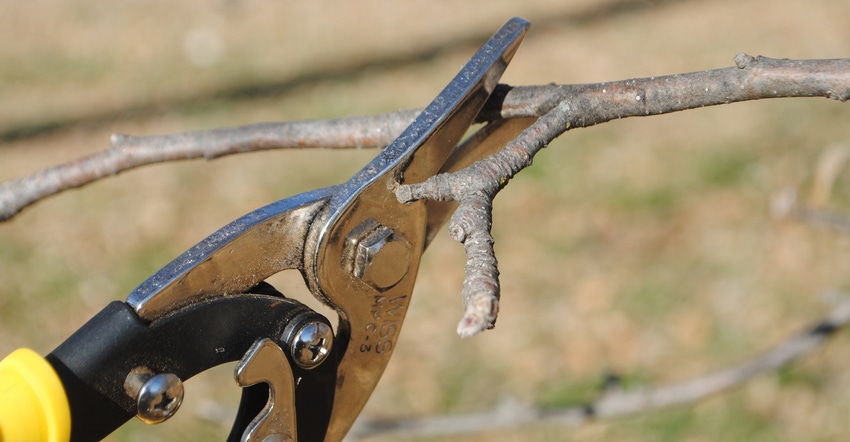February 4, 2021

Editor's note: In Farm and Garden this month, we asked Nebraska Extension educator Elizabeth Exstrom a question about the farmstead landscape this time of year.
What practical advice do you have for pruning flowering shrubs and roses?
Pruning is as much art as it is science. You could ask several gardeners how they would prune a particular plant, and they would all answer differently. Still, there are a few rules of thumb to follow.
Flowering shrubs and roses can be pruned for several reasons — to control their size, keep an attractive form, remove any dead or diseased wood, eliminate crossing or rubbing branches, or to keep the plant from becoming overgrown.
Safety also is a consideration. Branches might need to be trimmed that are causing obstructions or are sticking out into the sidewalk. Various species will require pruning at different times of the year and could require different pruning methods.
Removing dead, damaged or diseased branches or canes can be done at any time of the year. Removing crossing or rubbing branches is best done when the shrubs are dormant so the branching structure can be observed. Once these steps are complete, pruning should be done based on the goal for the plant, like to reduce size or increase flowering.
Proper identification is key to ensure that pruning is completed at the right time of year and using the right method for each plant:
Spring blooming shrubs. These should be pruned immediately or within a few weeks after flowering in April or May. They develop their buds for next year in the summer and fall, and if pruned too early or too late, the flower buds will be removed. These shrubs include lilac, forsythia, dogwood, spirea, spring blooming clematis, oakleaf hydrangea, bigleaf hydrangea, mockorange, Japanese quince, currant, spring blooming viburnum, weigela and yucca.
Summer blooming shrubs. These should be pruned in later winter or early spring before new growth begins. These develop flower buds in the spring on new growth. These include rose of Sharon, potentilla, summer blooming spirea, summer blooming viburnum, Hydrangea paniculate — and arborescens, hypericum, honeysuckle and shrubs with non-showy flowers such as barberry, privet, cotoneaster, deciduous euonymus, buckthorn and sumac.
The type of rose also can affect how it’s pruned:
Hybrid tea, grandiflora and floribunda roses. These should be pruned in late April or May, after winter protection is removed. Remove any winter-killed portions down to the next healthy bud. Make the cut at least 1 inch below the dead portion, and make the cut at a 45-degree angle away from the bud. Only remove dead or diseased canes.
Old-fashioned or species roses. These should be pruned after blooming. Reduce the length of the long canes by one-third and the lateral canes by a few inches. Prune repeat bloomers when dormant.
Shrub roses. These rarely require pruning. Occasionally dead or winter damaged canes will need to be removed.
Pruning methods also vary based on the condition of the shrub. Old, neglected shrubs can be restored by rejuvenation pruning, removing all stems or canes to just above ground level in late winter or early spring before new growth.
It might take several years for a shrub to bloom again after rejuvenation pruning. Shrubs that respond well include forsythia, weigela, mockorange, privet, honeysuckle, dogwood, viburnum, spirea, cotoneaster and established lilac.
You May Also Like




